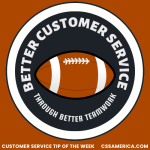
I’ve run into this personally and professionally, and it drives me batty! Sometimes there’s a lack of common sense in the customer service provided by companies. And often that lack of common sense is due to the preference of a business to provide service in a certain method, to stick to scripts and procedures, and to prioritize checking-off a task over actually helping a customer.
To ensure your organization provides Common Sense Customer Service, let’s walk through some basics that address how to serve customers based on how they reached out to you…
- If the customer e-mails, give them answers in the e-mail; possibly offer a phone call as an option to get more information, but don’t make a call the ONLY option for ANY information. Give them an answer via e-mail, even if it’s just preliminary or partial, and offer a link to a specific web page.
- If they e-mail a request or call in, don’t assume they’d prefer to visit your facility to address the need. Offer ways that they can get the need met without the effort of the onsite encounter.
- If they call to talk to someone who can help on an issue, assume they want to talk to a SPECIFIC PERSON THEN who can help; they’d prefer not to get to a voice mail, not to repeat their need 3 times to 3 different people, not to be told to “go to the website.”
- If they walk-in, expect a longer conversation than a call. If they spent an hour planning and conducting a roundtrip visit to see you, expect more than a 2-minute conversation.
- If they walk in with nothing, assume they may want to walk out with something. Be prepared to write down information for them, to offer a handout, to print a key page off the website.
- If they communicate via an online chat and convey the details of the situation at the start of the chat, assume they expect you to read that statement and not ask them questions they’ve already answered.
Sometimes the key to effective customer service starts with common sense. Base your response, in part, on how they reached out to you.
Do your part to make Common Sense Customer Service a common practice.
Signup for FREE Tips! Contact Us More Resources for You Visit Our Home Page















 Here are 3 customer service scenarios for a college IT department:
Here are 3 customer service scenarios for a college IT department:






